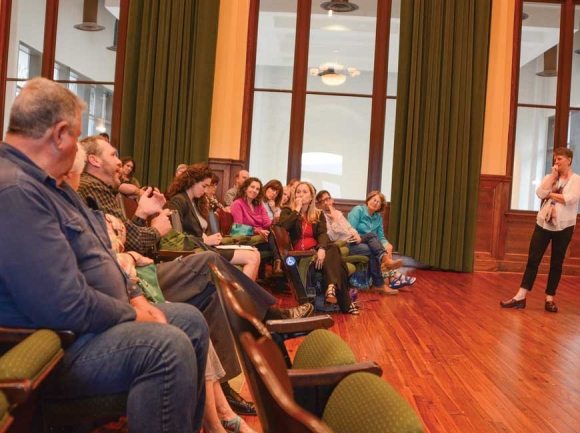DOT design for N.C. 107 ‘best option’ volunteer planners say
 The Asheville Design Team takes questions from community members present at the April 17 meeting. Holly Kays photo
The Asheville Design Team takes questions from community members present at the April 17 meeting. Holly Kays photo
The Asheville Design Center will soon complete its final recommendations for the N.C 107 project in Sylva, but the document is unlikely to provide any drastic departure from the plan already put forward by the N.C. Department of Transportation.
“We know this community has been looking at this project since the 1990s, and I know the town has been in this particular planning process for eight years,” ADC Director Chris Joyell told those attending a public meeting on the issue April 17. “So it shouldn’t come as a surprise that I don’t think we’re turning over any new stones at this point.”
Joyell — and the community at large — had hoped the conclusion would be different when the town of Sylva first accepted the ADC’s pro bono services in August.
Preliminary plans for the N.C. 107 project released last spring outlined an undertaking that would have massive, far-reaching impacts for the local economy, requiring 54 businesses, one nonprofit and five residences to relocate to make way for an expanded right-of-way. The figure is equivalent to about one-sixth of Sylva’s business community. A public forum to take input on the plans held Aug. 6 drew a crowd so large that the town’s meeting room could not hold all the people, with latecomers spilling into adjoining rooms to stand and listen to the goings-on in the main chamber. None of the 23 speakers supported the project as proposed.
The ADC used a team of seven volunteer professionals — including a traffic engineer, transportation planner, urban designer and multi-modal specialist — to gather community input and take a second look at the plans in search of a solution that might improve the road as needed without having such a drastic impact on local businesses. The process involved site visits, a focus group meeting, two community meetings, and a work session with the town and DOT as well as utilities. During the public meetings, residents put forth a variety of suggestions to improve the plan, which the ADC looked into. However, in nearly every case they found the proposed solution to be unworkable.
“We’re in a tricky situation where we’re like, ‘Hey, community, bring us all your ideas,’ and I feel like we’re coming to you having swatted down most of those ideas,” said Kristy Carter, an urban and transportation planner on the ADC team. “The plan, as impactful as it is, really is probably the best option of all the options that are out there.”
Related Items
The N.C. 107 project will run from the fire department on West Main Street all the way out to Ingles, also including a one-third mile section of U.S. 23 from McDonald’s to the intersection with 107. The plan is to get rid of the existing “suicide lane” that runs for most of that length and replace it with a grassy median that would force drivers to turn only at designated locations. The design also calls for bike lanes and improved sidewalks to encourage non-vehicular transportation.
Multi-modal
While the ADC team felt that, overall, the DOT’s plan is as good as can be expected considering the complexity of the project, they spent some time April 17 talking further about bike lanes and pedestrian facilities.
In terms of bike lanes, the current plan calls for nothing but a stripe of paint to separate the bikes from the cars. According to transportation planning specialist Rachel Bronson, that’s not a good idea. Federal guidelines that relate road volume to speed limit in order to determine the most appropriate bicycle facility would show that the 107 project falls well within the range of requiring a separated, greenway-like path.
“The challenge with this recommendation, even though it is the federally accepted recommendation, is it has so many constraints that really value it out,” Bronson said.
Increased right-of-way, additional costs and an extended timeline to complete the project are just some of the reasons Bronson said a separated path isn’t feasible. However, she said, the DOT should consider a buffered bike lane — a bike lane that has a strip of no-travel area to separate bikes and cars. She believes this could be done without requiring additional right-of-way if the vehicle lanes were built slightly narrower.
“What we don’t recommend, which is what is in the plan, is just a standard striped bike lane,” said Carter. “It may end up that’s what you get, but if we’re giving our professional judgment we have a hard time saying that’s an OK suggestion.”
Carter also suggested extra care be taken with designing intersections to be pedestrian-friendly.
“The advantage of a bike lane is instead of having this 4.5-foot buffer between cars and the sidewalk, you actually have 4.5 feet of grass, 2 feet of curb and gutter and the bike lane,” she said. “It’s really quite a wide buffer between the pedestrians and traffic, and that’s great. We don’t really have any improvement suggestions.”
However, she said, some of the intersections — especially the N.C. 107/U.S. 23 crossing — would benefit from pedestrian medians, signage and construction aimed at slowing down turning cars in order to make them more approachable for pedestrians.
Questions and answers
During the question-and-answer period following the presentation, some community members made it clear that they’d hoped to hear less about bike lanes and sidewalks and more about suggestions for reducing the project’s overall impact. Was the team going to go through the map with suggestions, one attendee asked?
“We don’t have any magic solution to make that better,” said Carter. “We feel like that’s a pretty good solution for the type of corridor that it is. So the short answer is no.”
“It seems like with almost every alternative we’re just shifting the burden from one property owner to another property owner, and we’re not really in the business of picking sides,” Joyell said earlier in the meeting. “At each one of these intersections it’s going to require some form of acquisition of property or condemnation of property.”
Transportation engineer Christy Staudt told attendees that their best chance of changing the course of their individual destinies would be negotiation during the right-of-way acquisition process, expected to begin in 2020.
“There’s room for negotiation, but it occurs during that right-of-way take aspect, and as a community there are some bigger, broader items that are more safety and enhancement that you might want to consider,” she said.
While it could be possible to trim a couple of feet off the road footprint, she said, the community might do better to focus its attention on getting the best long-term result possible from the road project — improved landscaping, lighting and other upgrades.
Those conclusions weren’t satisfactory for everybody.
“Some of us are worried about our business. We’re not as worried about the bicycle lanes,” said Jeannie Kelley, leader of the group Say No To The Road whose family owns three businesses within the project area.
“My question is, is this process going to be such that Asheville Design is going to address fundamentally flawed engineering design that has been presented to this community by the Department of Transportation and suggest alternatives that would work very easily?” said J.K. Coward, a Sylva attorney who heads up the Jackson County Smart Roads Alliance and has been outspoken against the plans presented.
For example, said Coward, the preliminary plans called for two bridges to be rebuilt in slightly different places than their current locations. If they were rebuilt in the exact same place, he said, at least a dozen businesses would be saved.
DOT Division Engineer Brian Burch, who attended the April 17 meeting, spoke up to say that, since the preliminary plans have been released, engineers determined that the bridge closest to town could be rehabbed within its existing footprint. However, he said, the other bridge would need to be replaced.
“Right, but is it something you could put back there in that same place?” asked Coward.
“They have to maintain traffic flow during this entire process,” said Joyell. “It has to function as a road while you’re trying to make it a better road.”
“Ethically we can’t just shut a road like that down,” agreed Staudt.
In response to Coward’s initial comments about the scope of the project, she said that the ADC hadn’t been engaged to do the full engineering study that would be required to say whether DOT had made a mistake in any of its plans.
“There are so many levels to this that unless you hire a firm to do a full engineering analysis, you can’t say DOT is doing this wrong,” she said.
The new road is needed, community members agreed. But apprehension remains as to what the project might ultimately cost the town.
“I feel like it’s going to be a loss for us as a town,” said Sylva resident Stacy Munn. “A lot of these businesses, I don’t see how they’re going to make it.”
The ADC team is in the process of finalizing its recommendations and will deliver them during a final presentation to town commissioners, with a date not yet set. Updated plans considered 65 percent complete are expected in June. These plans should more accurately reflect expected impacts to businesses along the corridor.









